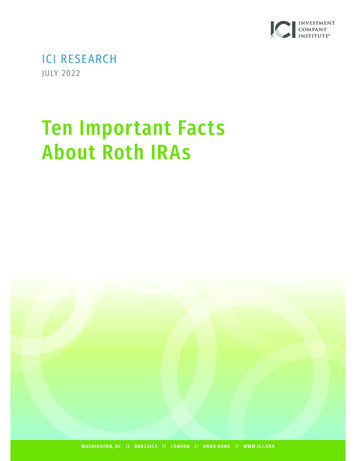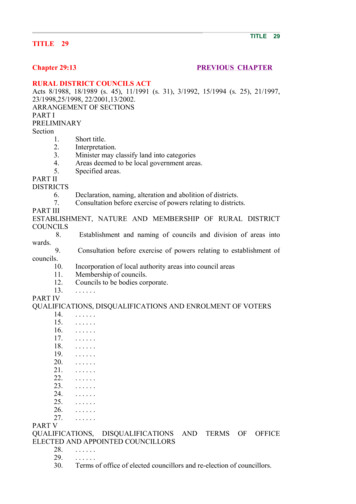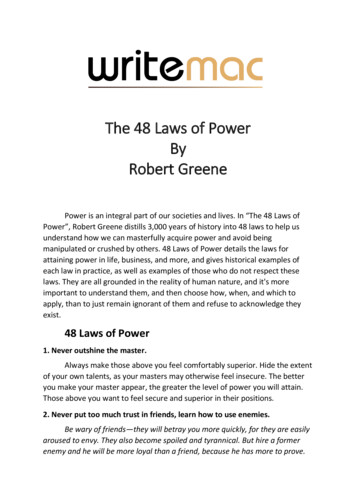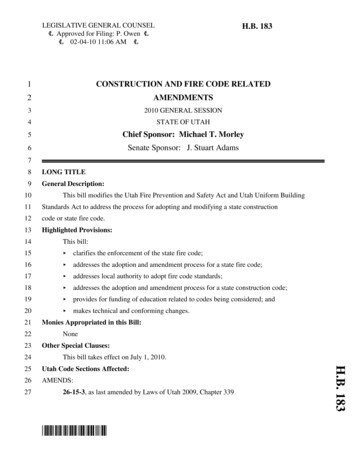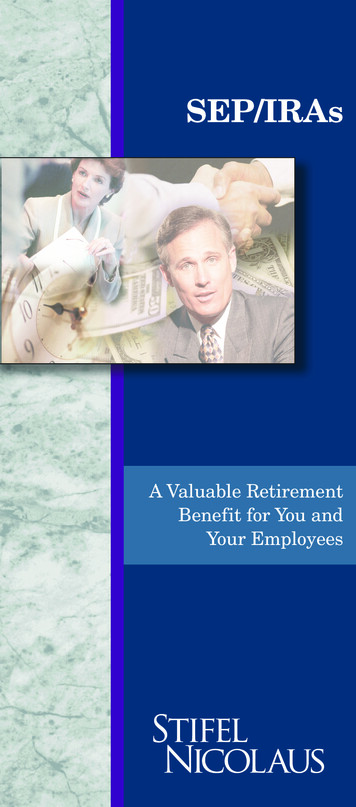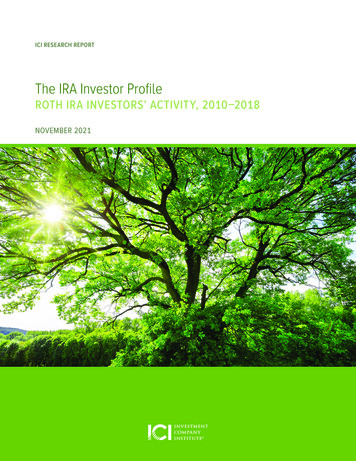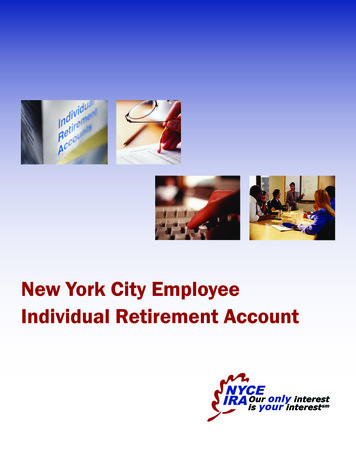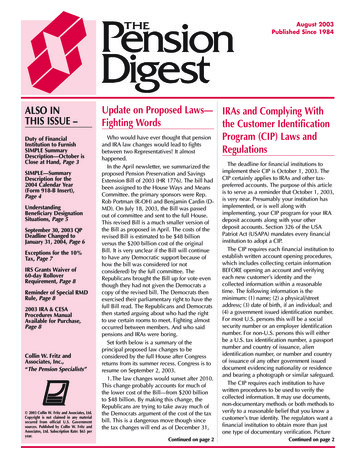
Transcription
August 2003Published Since 1984ALSO INTHIS ISSUE –Duty of FinancialInstitution to FurnishSIMPLE SummaryDescription—October isClose at Hand, Page 3SIMPLE—SummaryDescription for the2004 Calendar Year(Form 918-B Insert),Page 4UnderstandingBeneficiary DesignationSituations, Page 5September 30, 2003 QPDeadline Changed toJanuary 31, 2004, Page 6Exceptions for the 10%Tax, Page 7IRS Grants Waiver of60-day RolloverRequirement, Page 8Reminder of Special RMDRule, Page 82003 IRA & CESAProcedures ManualAvailable for Purchase,Page 8Collin W. Fritz andAssociates, Inc.,“The Pension Specialists” 2003 Collin W. Fritz and Associates, Ltd.Copyright is not claimed in any materialsecured from official U.S. Governmentsources. Published by Collin W. Fritz andAssociates, Ltd. Subscription Rate: 65 peryear.Update on Proposed Laws— IRAs and Complying WithFighting Wordsthe Customer IdentificationWho would have ever thought that pensionProgram (CIP) Laws andand IRA law changes would lead to fightsRegulationsbetween two Representatives! It almosthappened.In the April newsletter, we summarized theproposed Pension Preservation and SavingsExtension Bill of 2003 (HR 1776). The bill hadbeen assigned to the House Ways and MeansCommittee. the primary sponsors were Rep.Rob Portman (R-OH) and Benjamin Cardin (DMD). On July 18, 2003, the Bill was passedout of committee and sent to the full House.This revised Bill is a much smaller version ofthe Bill as proposed in April. The costs of therevised Bill is estimated to be 48 billionversus the 200 billion cost of the originalBill. It is very unclear if the Bill will continueto have any Democratic support because ofhow the bill was considered (or notconsidered) by the full committee. TheRepublicans brought the Bill up for vote eventhough they had not given the Democrats acopy of the revised bill. The Democrats thenexercised their parliamentary right to have thefull Bill read. The Republicans and Democratsthen started arguing about who had the rightto use certain rooms to meet. Fighting almostoccurred between members. And who saidpensions and IRAs were boring.Set forth below is a summary of theprincipal proposed law changes to beconsidered by the full House after Congressreturns from its summer recess. Congress is toresume on September 2, 2003.1. The law changes would sunset after 2010.This change probably accounts for much ofthe lower cost of the Bill—from 200 billionto 48 billion. By making this change, theRepublicans are trying to take away much ofthe Democrats argument of the cost of the taxbill. This is a dangerous move though sincethe tax changes will end as of December 31,Continued on page 2The deadline for financial institutions toimplement their CIP is October 1, 2003. TheCIP certainly applies to IRAs and other taxpreferred accounts. The purpose of this articleis to serve as a reminder that October 1, 2003,is very near. Presumably your institution hasimplemented, or is well along withimplementing, your CIP program for your IRAdeposit accounts along with your otherdeposit accounts. Section 326 of the USAPatriot Act (USAPA) mandates every financialinstitution to adopt a CIP.The CIP requires each financial institution toestablish written account opening procedures,which includes collecting certain informationBEFORE opening an account and verifyingeach new customer’s identity and thecollected information within a reasonabletime. The following information is theminimum: (1) name; (2) a physical/streetaddress; (3) date of birth, if an individual; and(4) a government issued identification number.For most U.S. persons this will be a socialsecurity number or an employer identificationnumber. For non-U.S. persons this will eitherbe a U.S. tax identification number, a passportnumber and country of issuance, alienidentification number, or number and countryof issuance of any other government issueddocument evidencing nationality or residenceand bearing a photograph or similar safeguard.The CIP requires each institution to havewritten procedures to be used to verify thecollected information. It may use documents,non-documentary methods or both methods toverify to a reasonable belief that you know acustomer’s true identity. The regulators want afinancial institution to obtain more than justone type of documentary verification. PictureContinued on page 2
August, 2003Page 2Update on Proposed Laws,Continued from page 1IRAs and CIP Laws and Regulations,Continued from page 12010 unless new legislation would be enacted extending thelaw changes.2. The 50% excise tax which applies to failed RMDdistributions would be reduced to 20%.3. The graduated IRA contribution limit changes as enactedby EGTRRA would be accelerated to be effective as of January1, 2004. The limit for years 2004-2010 would be 5,000 for aperson younger than age 50 and 6,000 for a person age 50 orolder.4. Under existing law, required distributions apply to aperson for the year he or she attains age 701 2. Age 72 wouldreplace age 701 2 for years 2004-2007, and age 75 wouldreplace age 72 for years 2010. There would be specialtransitional rules.5. The bill would allow certain recipients of pension and IRAdistributions during 2004-2008 to exclude 2,000 each year.This exclusion would apply only if the distributions qualify as a“lifetime annuity.” However, a series of substantially equalperiodic payments would qualify. The argument of thosewanting this change is that something needs to be done toencourage participants to not take lump sum distributions.6. The graduated 401(k) elective deferrals limit changes asenacted by EGTRRA would be accelerated to be effective as ofJanuary 1, 2004. The new limit for years 2004-2010 would be 15,000 for a person younger than age 50 and 20,000 for aperson age 50 or older.7. The proposed changes in the Saver’s credit were cut backsubstantially. The credit would apply to 2004-2010 rather thanthe change being permanent. The income limits would not bechanged from the 30,000/ 50,000 limits to 45,000/ 60,000.8. An IRA accountholder would be able to transfer anyportion of his or her IRA to a spouse at any time.9. Under current law, nonspouse beneficiaries do not haveany rollover rights. It does not matter if the paying entity is aqualified plan, 403(b), 457 plan or an IRA. Many qualified planadministrators either hate servicing inheriting beneficiaries orthey do a horrible job. There would be many rollovers bybeneficiaries if they could because many plans are written toforce beneficiaries to take their balances over a much shortertime period than the law permits. The beneficiary RMD ruleswould apply to such rolled over accounts.10. Participants of 401(k), 403(b) and 457(b) plans would beable to directly roll over (i.e. convert) their 401(k) funds into aRoth IRA. It would be a taxable event. The conversioneligibility rules would not be changed. This change makessense as long as the section 402(f) as furnished by theemployer properly explains the tax options and consequences.11. The Form 5500-EZ filing requirements for one-personplans would be changed. The 100,000 limit would bereplaced with a 250,000 limit.12. The Form 5500 filing requirements for plans will lessthan 25 participants would be simplified.IDs should be used to the extent available. Presumably, socialsecurity cards will also be used to a great extent. Nondocumentary verification methods include contacting thecustomer, contacting acquaintances of the customer, contactingdatabases, checking references, etc.The CIP must include procedures whereby the financialinstitution gives its customer adequate notice of this new rulerequesting information to verify each customer’s identity forsecurity purposes. Such notice requirement may be met byincluding a notice on the account application, posting a noticein the lobby for those customer who come into the institution,furnishing a brochure containing the notice, posting the noticeon the web site for those accounts being opened on the website, etc.The regulation sets forth the following model notice:IMPORTANT INFORMATION ABOUT PROCEDURESFOR OPENING A NEW ACCOUNTTo help the government fight the funding of terrorism andmoney laundering activities, Federal law requires allfinancial institutions to obtain, verify, and record informationthat identifies each person who opens an account.What this means for you: When you open an account, wewill ask for your name, address, date of birth, and otherinformation that will allow us to identify you. We may alsoask to see your driver’s license or other identifyingdocuments.The CIP will also need to define the procedures for recordretention. The final regulation has two record retentionrequirements. First, a financial institution will be required toretain the customer information (name, address, etc.) for fiveyears after the account is closed. Second, a financial institutionwill be required to retain all descriptions of any documentupon which you relied to verify a customer’s identity for fiveyears after the record is made. That is, you are not required toretain the actual document. The description should include thetype of document, any identification number(s) contained inthe document, and the issuance date and expiration date, ifapplicable. The description must also define the methods to beused to verify the identity of a customer, the results of search,and the resolution of any “substantive” discrepancy.The CIP must include procedures for determining if thecustomer appears on any list of known or suspected terrorists.Such lists have not yet been finalized. A financial institutionwill be notified by the Treasury or a regulator regarding whatlists must be consulted. The CIP procedure must define “when”such lists must be consulted. In general, it must happen withina reasonable period of time after the account is opened. Andthe CIP procedure must require the financial institution tocomply with all Federal directives issued in connection withsuch lists.Continued on page 3
August, 2003Page 3Duty of Financial Institutionto Furnish SIMPLE SummaryDescription—October is Closeat HandWhat are a financial institution’s duties if it is the custodianor trustee of SIMPLE IRA funds? After a SIMPLE IRA has beenestablished at an institution, it is the institution’s duty toprovide a Summary Description each year within a reasonableperiod of time before the employees’ 60-day election period.CWF believes that providing the Summary Description 30 daysprior to the election period would be considered “reasonable.”The actual IRS wording is that the Summary Description mustbe provided “early enough so that the employer can meet itsnotice obligation.” The employer is required to furnish thesummary description prior to November 1.IRS Notice 98-4 provides the rules and procedures forSIMPLEs. This notice is reproduced on page 17-67 of CWF’s2003 IRA Procedures Manual, which most of you should haverecently received. If you do not have this resource manual, anorder form is enclosed for your convenience.As you are probably aware, the employer may completeeither Form 5305-SIMPLE (where all employee’s SIMPLE IRAsare established at the same employer-designated financialinstitution) or Form 5304-SIMPLE (where the employer allowsthe employees to establish the SIMPLE IRA at the financialinstitution of their choice). No matter which of these forms arecompleted, the financial institution which is the trustee of anySIMPLE IRA funds is required to furnish the SummaryDescription. Even though an institution may only have arelationship with the individual accountholder and not theemployer, a relationship between the institution and theemployer is created simply because the funds are depositedinto the SIMPLE by the employer.There is also what is termed a “transfer” SIMPLE IRA. If yourinstitution has accepted a transfer SIMPLE IRA, and there havebeen no employer contributions, then there is no duty tofurnish the Summary Description. However, if there is theexpectation that future contributions will be made to thistransfer SIMPLE IRA, then the institution will have the duty tofurnish the Summary Description.The penalty for not furnishing the Summary Description is 50 per day.The law actually states that the Summary Description mustbe furnished to the employer. However, the IRS has issuedwritten guidance (Notice 98-4) which allows an institution tofurnish the Summary Description to the individual employee,instead.If an institution furnishes the Summary Description to anemployee, it must include: A current 5304-SIMPLE — this could be filled out by theemployer, or it could be the blank form Instructions for the 5304-SIMPLE Information for completing Article VI (Procedures forwithdrawal) (You will need to provide a memoexplaining these procedures.) The financial institution’s name and address.The trustee should also provide guidance to either theemployer or the employee concerning the need for theemployer to complete the first two pages of the form and theprovision that it must be distributed to all eligible employees.Obviously, if an institution provides the employee with a blankform, he/she will need to have the employer complete it, and,the employee may well need to remind the employer that itneeds to provide the form to all eligible employees.CWF has created a form (reproduced in this newsletter)which covers the approach of the Summary Description beingprovided to the employees.Additional Reporting Requirements —The trustee must also provide each participant with astatement showing the account balance as of 12/31 of eachyear (this is the same as for the traditional IRA), and include theactivity in the account during the calendar year (this is notrequired for a traditional IRA). There is a 50 per day fine forfailure to furnish this statement (with a traditional IRA, it wouldbe a flat 50 fee). CWF also suggests providing a memo ofexplanation.IRAs and CIP Laws and Regulations,Continued from page 2Summary CIP applies to the opening of IRA accounts andother tax preferred accounts. Each financial institution mustfully implement its CIP by October 1, 2003. With respect totraditional IRA and Roth IRA accounts, CWF has prepared aform to be used to allow you to verify a customer’s identitybefore he or she opens the traditional IRA or the Roth IRA.CWF has also written a Customer Identification Procedure tobe used by a financial institution with respect to opening IRAaccounts and other accounts. An institution may modify it to fitits particular circumstances.
August, 2003Page 4
August 2003Page 5Understanding BeneficiaryDesignation SituationsThe provisions governing beneficiary designations areincluded in both the IRA plan agreement and the designation ofIRA beneficiary forms. An IRA accountholder has the right todesignate his/her primary beneficiaries and his/her contingentbeneficiaries.The IRA plan agreement provides that if the accountholderdoes not name a beneficiary or if none of the namedbeneficiaries are alive on the date of the accountholder’s death,then the assets will be paid to the accountholder’s estate.Under the CWF forms, a contingent beneficiary receives orinherits an interest only if there is no primary beneficiary. Thismeans that if there is at least one primary beneficiary, then thecontingent beneficiary(ies) will not receive any portion (as acontingent beneficiary).Section 1.7 of Article VIII of the IRA plan agreement providesthat an IRA accountholder must inform each person who hasbeen designated as the accountholder’s beneficiary that he orshe is a beneficiary and that they have the duty of notifying theIRA custodian of the accountholder’s death.The form contemplates the possibility that the accountholderwill designate one or more primary beneficiaries and one ormore contingent beneficiaries and then one or more of theseindividuals may die before the accountholder. It wouldcertainly be best if the accountholder would execute a newbeneficiary form after a designated beneficiary predeceases theaccountholder, but the form is written to define what theaccountholder wants to have happen if a beneficiarypredeceases him or her.For this special situation, the form provides two options—aper capita approach and a per stirpes approach. The per capitaapproach is deemed elected if neither approach is expresslyelected.Under the per capita approach, the form provides the resultthat the interest of that deceased beneficiary (and all heirs) shallterminate totally, and the shares of the other primarybeneficiary(ies) will consequently increase.Note that under the per capita approach, if only one personis named as a primary beneficiary, and there is one or morepersons named as contingent beneficiaries, and the primarybeneficiary predeceases the accountholder, then the contingentbeneficiaries, in effect, become the primary beneficiaries. Thisis not necessarily the result under the per stirpes approach.Under the per stirpes approach, the form provides that theinterest of the deceased beneficiary shall be paid to his or herheirs (or issue) who are alive or who have living issue. Suchheirs or issue take the decedent’s share by right ofrepresentation. Persons of the same class shall share equally.For example, in 1997 when establishing her IRA, Katherine Bellhad designated her three daughters (Maria, Nancy, and Lynn)as her primary beneficiaries. Each was to receive a 1/3 share.Maria has one son, David. Nancy has a daughter, Betty, and ason, David. Lynn has two sons, Mark and Tom. Katherine Bellhad elected the per stirpes approach and she had designatedher church as her contingent beneficiary. Nancy died on June30, 2003 and Katherine died on July 15, 2003. Maria receivesa 1/3 interest, Lynn receives a 1/3 interest, and Betty and Davidwill share the 1/3 interest which would have gone to theirmother, Nancy, if she had survived Katherine.The per stirpes approach serves the concept that manyindividuals do not wish to favor one family member overanother family member. This is generally true for familymembers of the same class (i.e. children). If a child beneficiarypredeceases the accountholder, then the accountholder manytimes wants that deceased child’s share to go to that child’schildren (i.e. the grandchildren) rather than to the deceasedchild’s brothers or sisters.Note that the per stirpes approach has the effect of replacingone primary beneficiary with another primary beneficiary(ies).The situation may arise where a person will be both aprimary beneficiary and also a contingent beneficiary. In sucha situation, being a primary beneficiary takes precedence overbeing a contingent beneficiary. For example, David Clark hasan IRA. He has been married to Ann for 34 years. They havefour children (Missy, Fred, Mark and Ben). He designates hiswife, Ann, to be his primary beneficiary. For whatever reason,he only names Missy to be his contingent beneficiary. He hadchecked the per stirpes box (box 2). If Ann predeceases David,then we believe all four children become the primarybeneficiaries of David Clark’s IRA. The fact that Missy hasalready been designated as the contingent beneficiary does notmean that she has a greater right to the IRA than her threebrothers who were not named as contingent beneficiaries. Allfour were substituted as primary beneficiaries once Ann died.Also note that the per stirpes rule applies to both primaryand contingent beneficiaries. That is, in some situations, a perstirpes contingent beneficiary may inherit his or her share of adeceased accountholder’s IRA.For example, Mary Doe maintains an IRA. She is age 44. Shehas one daughter, Amy, age 13 who is designated as theprimary IRA beneficiary. Amy does not have any issue. Marydesignates her brother, John Doe, and her sister, Alice Doe, tobe the contingent beneficiaries. Each is to receive a 50% share.John has one child, Vivian. Alice has one son, Marty.Alice and Amy were killed in a car accident on May 22,2003, as they were returning from Amy’s gymnastics practice.Mary died unexpectedly of a heart attack on July 15, 2003.Amy’s interest never came into being and passed to thecontingent beneficiaries since she did not have any issue. Johninherits 50% of Mary’s IRA as he was directly designated as acontingent beneficiary. Marty also inherits 50 percent of Mary’sContinued on page 6
August 2003Page 6Understanding Beneficiary Designation Situations,Continued from page 5IRA as he takes his mother’s (Alice’s) share under the per stirpesprovision.If the per stirpes box has been checked, once an IRAcustodian has knowledge that an accountholder has died andthat a designated beneficiary had predeceased theaccountholder, then the IRA custodian has the duty to gatherthe necessary information to determine who is a “per stirpes”primary beneficiary. The IRA custodian would need to askfamily members to answer various questions and providedocumentation demonstrating who qualifies as issue of thepredeceased beneficiary. No payment would be necessary untilthe IRA custodian had made this determination.The term “issue” has the general meaning of a linealdescendant (e.g. child, grandchild, great-grandchild, etc.)Normally, this term does not cover one’s spouse. CWF will bemodifying its forms to make clear that a spouse is not “issue.”September 30, 2003 QP DeadlineChanged to January 31, 2004We did not think the IRS would do it, but they have againchosen to extend the deadline for certain qualified plans toadopt the GUST remedial amendment. The IRS recently issuedRev. Proc. 2003-72. The new deadline for GUST amendmentsis January 31, 2004, if certain conditions are met. One of thoseconditions is that the plan must file a request for the issuanceof a favorable determination letter on or before January 31,2004. For some plans there will be a second condition; theywill be required to pay a special fee of 250.The IRS has also chosen to extend the deadline for adoptingan RMD amendment. In general, the deadline had been the lastday of the first day of the plan year commencing on or afterJanuary 1, 2003. For calendar year plans this deadline wasDecember 31, 2003. The QP sponsor was required to furnish acopy of the RMD amendment to an adoption employer byDecember 31, 2003. The new deadline will be the 91st dayfollowing the IRS’ issuance of a favorable determination letteras filed pursuant to Rev. Proc. 2003-72.The new deadline of January 31, 2004, will apply to twocategories of plans.Category #1. The sponsoring employer ADOPTS its GUSTrestated plan on or before September 30, 2003, but does notsubmit its request for a favorable determination letter bySeptember 30, 2003, but does submit it on or before January31, 2004.Under prior rules the adopter of a non-standardizedprototype was only able to qualify for the September 30, 2003,deadline if it filed its request for the issuance of a favorabledetermination letter on or before September 30, 2003. Thus,the IRS has decided to be nice to those employers whoadopted the GUST amendment on or before September 30,2003, by granting them an additional four months to make theIRS filing. CWF and other pension consulting firms willappreciate being given an additional four months to completethe determination letter filings. I would expect the IRS alsomade this change to help the IRS. The IRS very well may beoverwhelmed with such determination letter filings, and withthis extension, the IRS will be able to handle this work moreefficiently.Category #2. A sponsoring employer of a prototype planFAILS to adopt its GUST plan on or before September 30, 2003.An employer sponsoring a standardized prototype may fallinto this category just as an employer sponsoring a nonstandardized prototype may.Such an employer will still be able to amend its plan forGUST as long as it adopts it GUST restated plan on or beforeJanuary 31, 2004, submits its request for a favorabledetermination letter by January 31, 2004, and includespayment of a 250 compliance fee. Again, an employer whoadopts a standardized GUST prototype after September 30,2003, will be required to make the IRS determination letterfiling. The charging of the 250 compliance fee should raisesome revenue for the U.S. Treasury.Note that this extension applies only if the plan’s GUSTremedial amendment deadline ends on or after September 30,2003, and before January 1, 2004. That is, there is no extensionif the employer’s plan was an individually designed plan forwhich the GUST amendment was not adopted on or before thelater of: February 28, 2002, or the last day of the plan yearbeginning on or after January 1, 2001—unless the employeradopted a prototype plan as sponsored by a financial institutionwhich had submitted its GUST revised prototype on or beforeDecember 31, 2000, or certified their intent to adopt such aplan.CWF still strongly recommends that an employer adopts itGUST plan on or before September 30, 2003.The IRS has also issued Revenue Procedure 2003-44. Itdescribes in detail the Employee Plans Compliance ResolutionSystem (EPCRS), a comprehensive system of correctionprograms that permits plan sponsors to correct qualificationfailure in order for a plan to preserve its tax qualified status. Anemployer who did not timely amend its plan for GUST, or whofails to file, if required, its determination letter application on orbefore January 31, 2004, will need to use EPCRS.
August 2003Page 7Exceptions for the 10% TaxCWF has prepared the following chart to hopefully make iteasier for you to understand the numerous exceptions to the10% additional tax rule. The general rule is that a recipient of adistribution before age 591 2 will owe an additional 10% tax.The law is written to penalize individuals who withdraw fundsfrom an IRA or pension plan and use it for reasons other thanretirement. The individual will also include this distribution inhis or her gross income and pay tax at the marginal tax ratewhich applies to him or her.Observation1. There is no exception to the 10% tax just because thedistribution is on account of a “hardship.” The hardship rulesmay allow a 401(k) participant to receive a distribution, but theperson will owe the additional 10% tax.2. There is no exception to the 10% tax just because theemployer terminates the 401(k) or other pension plan.3. The first-time home buyer exception applies to IRAdistributions It does not apply to distributions from 401(k) plans.The 10% tax will be owed if a 401(k) participant takes adistribution from a 401(k) plan to purchase a house.4. In some situations, a person does NOT want to directly rollover his or her entire 401(k) account. Rather, a person will wantto instruct the plan administrator to distribute a certain amountof cash and to directly roll over the remainder.For example, one of your customers, Thomas Juergens, isgoing through a divorce. His wife has a 401(k) plan and thecourt order rules he is entitled to 30,000 of her 401(k). He isentitled to have direct rollover to an IRA, if he so chooses.Thomas would like to receive 5,000 in cash to pay off somedebts. He would like to roll over the remainder.Thomas has two options. Option #1 is to directly roll over the 30,000 to an IRA and then withdraw the 5,000 from the IRA.Since the withdrawal has come from the IRA, he will owe the10% additional tax, or 500 ( 5,000 x 10%). Option #2 is toinstruct the 401(k) plan to pay him 5,000 (less 20%withholding) and to directly roll over the remaining 25,000.Since the distribution is from the 401(k) plan, he will NOT owethe additional 10% tax. Obviously, in this situation, Thomaswould want to use Option #2 if he understood the rules. Asimilar type situation exists when a person is a participant in apension plan and separates from service after attaining age 55.Any fund withdrawn from the pension plan will escape the 10%tax whereas if the participant directly rolls over all of his or herfunds to an IRA and then takes a distribution he or she will owethe 10% additional tax.5. Every distribution to a beneficiary escapes the 10%additional tax. A spouse who has elected to treat a deceasedspouse’s IRA as his or her own IRA or has rolled over thedeceased spouse's QP balance to an IRA is no longer a“beneficiary.” Any distribution from his or her IRA will be assesthe 10% additional tax unless “another” exception would apply.DoesExceptionApplyfor an IRADistributionDoesExceptionApply fora Distributionfrom a QRP1. Made to IRA accountholderor QRP participant who is age591 2 or older at the timeof distribution.YesYes2. Made to a beneficiary or estate onaccount of the IRA accountholder’sor QRP participant’s death.YesYesDescriptionof DistributionReason3. Made to IRA accountholder or QRPparticipant on account of disability.YesYes4. Due to an IRS levyYesYes5. Made for the IRA accountholder orQRP participant’s (and dependent’s) —not in excess of unreimbursed medicalexpenses that are more than 75% ofthe person’s AGI.YesYes6. Made as part of a series of substantially equal period paymentsover your life or life expectancy.YesYes*7. Distributions made to the participantafter he or she separated from servicewith the employer, if the separationoccurred in or after the year he orshe reached age 55.NoYes8. Distributions made to an alternatepayee under a qualified domesticrelations order.NoYes9. Distributions of dividends fromemployee stock ownership plans.NoYes10. Distributions equal to or less thanthe IRA accountholder (and certainfamily members) qualified highereducation expenses.YesNo11. Distributions made to pay for afirst-time home purchase.YesNo12. Distributions made to pay healthinsurance premiums if you areunemployed.YesNo13. Distributions converted to a Roth IRA.YesNo*If from a QRP, the participant mustseparate from service with theiremployer before the payouts beginfor this exception to apply.
August 2003Page 8IRS Grants Waiver of 60-dayRollover Requirement2003 IRA Procedures ManualAvailable for PurchaseFor distributions occurring on or after January 1, 2002,EGTRRA authorized the IRS to wa
the Customer Identification Program (CIP) Laws and Regulations The deadline for financial institutions to implement their CIP is October 1, 2003. The CIP certainly applies to IRAs and other tax-preferred accounts. The purpose of this article is to serve as a reminder that October 1, 2003, is very near. Presumably your institution has
